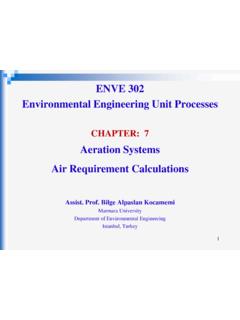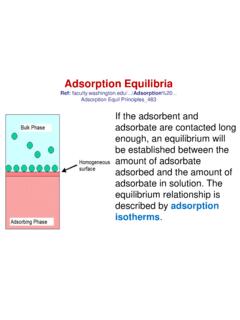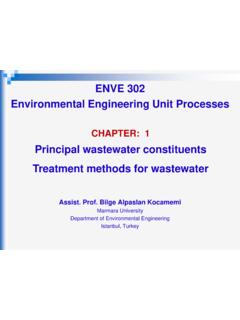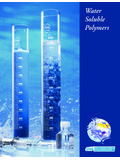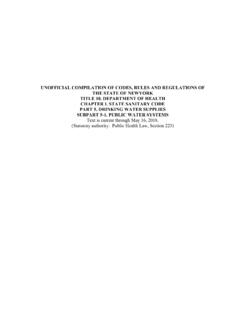Transcription of CHAPTER: 9 Design of Rapid mixing (Coagulation) …
1 ENVE 301 Environmental Engineering Unit OperationsDesign of Rapidmixing( coagulation ) CHAPTER: 9 1 Assist. Prof. Bilge Alpaslan KocamemiMarmara UniversityDepartment of Environmental EngineeringIstanbul, TurkeyRapidmixing( coagulation ) Slow mixing ( flocculation ) UnitsDESIGN OF Rapid mixing ( coagulation ) UNITSR apid mixing unit : provide complete mixing of the coagulant and raw water. Destabilization of colloidal particleEarly stages of floc formation Hydraulic mixing units( )occur in Rapid mixing unit Hydraulic mixing units( ) Mechanically mixing units (see ) Design Criteria: G for Rapid mix 700-1000 sec-1t (detention time) for Rapid mixing 20-60 sec2 may be single compartment or double compartment Single compartment basins are usually circular or square in plan viewLiquid depth = 1-1,25 x (basindiameteror width)( )Liquid depth = 1-1,25 x (basindiameteror width)( ) Small baffles are desirable to minimize vortexing.
2 (See )3 Design OF SLOW mixing ( flocculation ) UNITSD estabilized colloids resulting from coagulation may still settle very slowly flocculation is a slow mixing process in which these particles are bought into contact in order to promote their objective of flocculation is to provide increase in the number of contacts between coagulated particles bygentle and prolonged agitation4 Devices used to accomplish mixing required for flocculation mechanically driven paddles baffled channels )flocdense/light(G510Gt1-sec 75-10 10 Design Criteria :5)floceargl/small(min3010t basin) in the opputinity(contact =)floceargl/small(min3010t)flocdense/lig ht(G510Gt basin) in the opputinity(contact 1-sec 75-10 10 = If G is too great shear forces will prevent the formation of large flocIf G is insufficient adequate collision will not occur 6If G is insufficient adequate collision will not occur proper floc will not formedHigh Gt large # of collisions In the Design of flocculation systems.
3 The total number of particle collision is indicated as a function of the product of the velocity gradient and detention time(Gt) mixing in an individual flocculator basin hydraulic flow regime approaching complete conditions are desirable to minimize short-circuiting of the flowShort circuiting a portion of the incoming flow traverses the chamber in a much shorter time than the nominaldetentionperiodnominaldetentionpe riodtwo or more basins in series (TAPERED flocculation )promote plug flow through the system(ensure that all particles are exposed to mixing for a significant amount of the total detention time allows the G value to be decreased from one compartment to next as the average floc size G at the inlet max.)
4 mixing to enhance aggregationTapered FloculationFlow is subjected to decreasing G values as it passes through theflocculation basinrapid build up of small dense floc which subsequently aggregates at lower G values into larger , dense, Rapid settling floc , dense flocs8 Large G , low t small but dense flocsLow G , high t larger but lighter flocsGood floc :Large and denseaggregationLow G at the outlet promotes larger flocs by reducing Small dense mixing and sheer. flocs combine into larger , dense flocsTapered flocculation : Typical series of G 80, 40, 20 sec-1 For mechanical mixing flocculators Variable speed motors should be provided to change the power inputas required with changes in Temperature9 Temperature Q Water qualityThe compartments are often separated with a PATTERN (blades are perpendicular to flow) the paddle size the number of paddles diameter of the paddle wheels on the various horizontal shafts the rotational speed of the various horizontal shafts10 Tapered flocculation may be provided by varying AXIAL FLOW PATTERN(Blades are parallel toflow)
5 The paddle size number of paddles on each paddle wheel having a common horizontal flocculation may be obtained by varyingEXAMPLE (Paddle wheel flocculator Design )A cross flow horizontal shaft, paddle wheel tapered flocculation basin with 3 compartments squarein profile having equal depths are to be designed for a flow MGD. Each horizontal shaft willhave 4 paddle wheels and each paddle will have 6 blades each having a width of 6 inch and length of10 ft. 12in space will be left between each time is 50 min. The G values determined from lab. tests for 3 compartments are; G1=50sec-1, G2=25 sec-1, G3=15 sec-1. These give an average G value of 30 sec-1. The compartments are tobe separated by baffle fences.
6 The basin should be 50ft in width. The speed of blades relative tothe water is 3 quarters of the peripheral blade speed. Determine:a)The Gt value,b)The basin dimensions,c)The paddle-wheel Design ,d)Power to be imparted to thewaterineachcompartment,e)Therotationa lspeedofeachhorizontalshaftinrpm12wateri neachcompartment,e)Therotationalspeedofe achhorizontalshaftinrpm = Horizontal flow (around the end) Vertical flow (over and under)BAFFLED CHANNEL FLOCCULATORS13 can be used for large treatment plants (Q>10000m3/day) where theflowrates can maintain sufficient headlosses in the channels for slowmixing without requiring that baffles be spaced too close together (whichwould make cleaning difficult)
7 14 A distinct advantageThey operate under plugof such flocculatorsflow conditionsfree from shortcircuiting problemsThe number of baffles needed to achieve a desired velocitygradient:FOR HORIZONTAL FLOW(around the end) BAFFLEDFLOCCULATOR() + =n = number of baffles in the basinH = depth of water in the basin (m)L = length of the basin (m)G = velocitygradient(sec-1)15G = velocitygradient(sec-1)Q = flowrate (m3/sec)t = time of flocculation (sec) = dynamic viscosity ( ) =density of water (kg/m3)f = coefficient of friction of the bafflesw = width of the basin (m)HEADLOSS AROUND THE BAFFLE IN A CHANNEL can be computed by assuming 180 turn in thedirection of flow in a square pipeh= (v 2g)() + =FOR VERTICAL FLOW (over and under) BAFFLEDFLOCCULATORn = number of baffles in the basinH = depth of water in the basin (m)L = length of the basin (m)
8 G = velocitygradient(sec-1)16G = velocitygradient(sec-1)Q = flowrate (m3/sec)t = time of flocculation (sec) = dynamic viscosity ( ) =density of water (kg/m3)f = coefficient of friction of the bafflesw = width of the basin (m)HEADLOSS AROUND THE BAFFLE IN A CHANNEL can be computed by assuming 180 turn in thedirection of flow in a square pipeh= (v 2g)Water velocity in both horizontal flow and vertical flow units m/secDetention time varies from 15-30 minG = 10-100 sec-1 Other Design criteria: Table (Okun)Tapered energy flocculation in baffled channels generally is achieved byvarying the spacing of the baffles. That is;Close spacing of baffles for high velocity gradientsWider spacing of baffles for low velocity gradients17 EXAMPLE (Fair, Geyer, Okun ) Design a horizontal flow baffled channel flocculatorfor a treatment plant of 10000m3/day capacity.
9 The flocculation basin is to be divided into 3 sections of equal volume, each section having constant velocity gradients of 50, 35, 25 s-1, respectively. The total flocculation time is to be 21 min and the water temperature is 15 C. The timber baffles have a roughness coefficient of A common wall is shared between the flocculation sedimentation basins, hence the length of the flocculatoris fixed at 10m. A sedimentation basins, hence the length of the flocculatoris fixed at 10m. A depth of 1m is reasonable for horizontal flow 15 C = 10-3kg/msec = 1000 kg/m318

